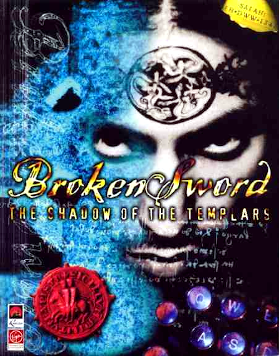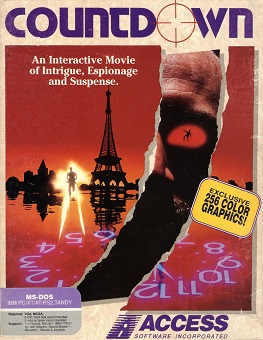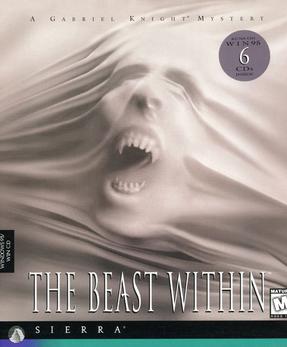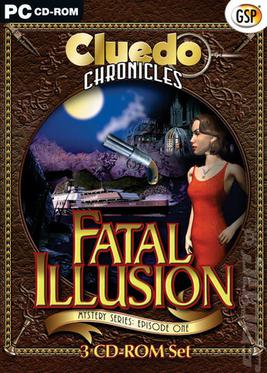Broken Sword is a series of adventure games. The first game in the series, Broken Sword: The Shadow of the Templars, was released and developed in 1996 by British developer Revolution Software. Its sequel, Broken Sword II: The Smoking Mirror, was released a year later, and was followed by Broken Sword: The Sleeping Dragon in 2003, Broken Sword: The Angel of Death in 2006, and Broken Sword 5: The Serpent's Curse in 2013. A remake of the first game in the series, known as Broken Sword: Shadow of the Templars – The Director's Cut, was released in 2009, and a remake of the second game in the series, Broken Sword: The Smoking Mirror – Remastered, in 2010 for iOS devices; other platforms followed in 2011.

Under a Killing Moon is a 1994 point-and-click adventure interactive movie video game. It is the third installment in the Tex Murphy series of adventure games produced by Access Software. In it, the detective Tex Murphy finds himself unwittingly involved in the affairs of a dangerous cult.

Titanic: Adventure Out of Time is a 1996 point-and-click adventure game developed by CyberFlix and published in the United States and United Kingdom by GTE Entertainment and Europress respectively, for Windows and Macintosh. It takes place in a virtual representation of the RMS Titanic, with the player assuming the role of a British spy who has been sent back in time to the final night of the Titanic and must complete a previously failed mission to prevent World War I, the Russian Revolution, and World War II from occurring. The gameplay involves exploring the ship and solving puzzles. There are multiple outcomes and endings to the game depending on the player's interactions with characters and use of items.

Krome Studios Melbourne, originally Beam Software, was an Australian video game development studio founded in 1980 by Alfred Milgrom and Naomi Besen and based in Melbourne, Australia. Initially formed to produce books and software to be published by Melbourne House, a company they had established in London in 1977, the studio operated independently from 1987 until 1999, when it was acquired by Infogrames, who changed the name to Infogrames Melbourne House Pty Ltd.. In 2006 the studio was sold to Krome Studios.
An interactive film is a video game or other interactive media that has characteristics of a cinematic film. In the video game industry, the term refers to a movie game, a video game that presents its gameplay in a cinematic, scripted manner, often through the use of full-motion video of either animated or live-action footage.

Mystery House is an adventure game released by On-Line Systems in 1980. It was designed, written and illustrated by Roberta Williams, and programmed by Ken Williams for the Apple II. Mystery House is the first graphical adventure game and the first game produced by On-Line Systems, the company which would evolve into Sierra On-Line. It is one of the earliest horror video games.

The Daedalus Encounter is a 1995 interactive movie puzzle adventure game developed by Mechadeus and published by Virgin Interactive for Windows. The game was ported to the 3DO by Lifelike Productions and published by Panasonic. The premise of the game is that there are three space marines who have fought as part of an interstellar war. One of them, Casey, has been brought back to life by his partners after a space accident and he is now a brain grafted in a life-support system. In order to save themselves, the three characters and the player solve all sorts of puzzles.

Phantasmagoria is a point-and-click adventure horror video game designed by Roberta Williams for MS-DOS and Microsoft Windows and released by Sierra On-Line on August 24, 1995. It tells the story of Adrienne Delaney, a writer who moves into a remote mansion and finds herself terrorized by supernatural forces. It was made at the peak of popularity for interactive movie games and features live-action actors and footage, both during cinematic scenes and within the three-dimensionally rendered environments of the game itself. It was noted for its violence and sexual content.

Broken Sword: The Shadow of the Templars is a 1996 point-and-click adventure game developed by Revolution Software. It is the first in the Broken Sword series, co-written and directed by Charles Cecil. The player assumes the role of George Stobbart, an American tourist in Paris, as he attempts to unravel a deep conspiracy involving a sinister cult and a hidden treasure, seeing him travel to various locations around Europe and the Middle East. The game's storyline was conceived to feature a serious tone and heavily influenced by research on Knights Templar by Cecil, but was also interlaced with humor and graphics in the style of classic animated films.

Countdown is a point-and-click adventure game released by Access Software for MS-DOS in 1990. The game was re-released on GOG.com on 26 July 2021.

The Beast Within: A Gabriel Knight Mystery is a point-and-click adventure game, created by Jane Jensen, developed and published by Sierra On-Line, and released for MS-DOS, Macintosh, and Microsoft Windows, in 1995. The sequel to 1993's Gabriel Knight: Sins of the Fathers, the game's story focuses on a new investigation for Gabriel Knight, adjusting to his new life as a "shadow hunter", as he investigates a spate of killing around Munich believed to be the work of a werewolf, with assitance in his work from Grace Nakimura, who looks into a link between the killings and the final years of a Bavarian king in the 19th century.

Temüjin is a 1997 computer game developed and published by SouthPeak Interactive.

Touché: The Adventures of the Fifth Musketeer is a point-and-click graphic adventure game developed by the Clipper Software.
An adventure game is a video game genre in which the player assumes the role of a protagonist in an interactive story, driven by exploration and/or puzzle-solving. The genre's focus on story allows it to draw heavily from other narrative-based media, such as literature and film, encompassing a wide variety of genres. Most adventure games are designed for a single player, since the emphasis on story and character makes multiplayer design difficult. Colossal Cave Adventure is identified by Rick Adams as the first such adventure game, first released in 1976, while other notable adventure game series include Zork, King's Quest, Monkey Island, Syberia, and Myst.

Disney's Animated Storybook is a point-and-click adventure interactive storybook video game series based on Walt Disney feature animations and Pixar films that were released throughout the 1990s. They were published by Disney Interactive for personal computers for children ages four to eight years old. Starting from 1994, most of the entries in the series were developed by Media Station. They have the same plots as their respective films, though abridged due to the limited medium.

Anastasia: Adventures with Pooka and Bartok is a puzzle video game based on the 1997 animated film Anastasia. Developed by Motion Works, published by Fox Interactive and distributed by 20th Century Fox Home Entertainment, the title was released on November 25, 1997. It was produced by David Wisehart, who also served as voiceover director. The game had an estimated budget of US$800,000.

Clue Chronicles: Fatal Illusion is a Windows point-and-click adventure game based on the Cluedo franchise, known as Clue in North America. It is a reinterpretation and adaption of the Clue board game as an adventure game including many of the original characters. The game was distributed with a variety of covers, each featuring a different murder weapon.

The Legend of the Prophet and the Assassin is an adventure game by Arxel Tribe. It is the sequel to Pilgrim: Faith as a Weapon. It was released in October 2000 for Windows. The game is inspired by the work of Brazilian novelist Paulo Coelho. A sequel, The Secrets of Alamût was released in March 2001.

Santa Fe Mysteries: The Elk Moon Murder is a video game, the first in the Santa Fe Mysteries series, followed by Santa Fe Mysteries: Sacred Ground. In The Elk Moon Murder, a famous Native American artist named Anna Elk Moon is murdered in the American Southwest.

Sex Vixens from Space is an erotic interactive fiction game developed and self-published by Free Spirit Software and originally released in 1988 for the Commodore 64 and Apple II as part of the compilation Sex And Violence Vol. 1. It was released as a standalone game, with the addition of graphics, in November 1988 for DOS and Amiga and in 1989 for the Atari ST. Sex Vixens was inspired by the 1974 sexploitation film Flesh Gordon. The game was panned by reviewers.

















